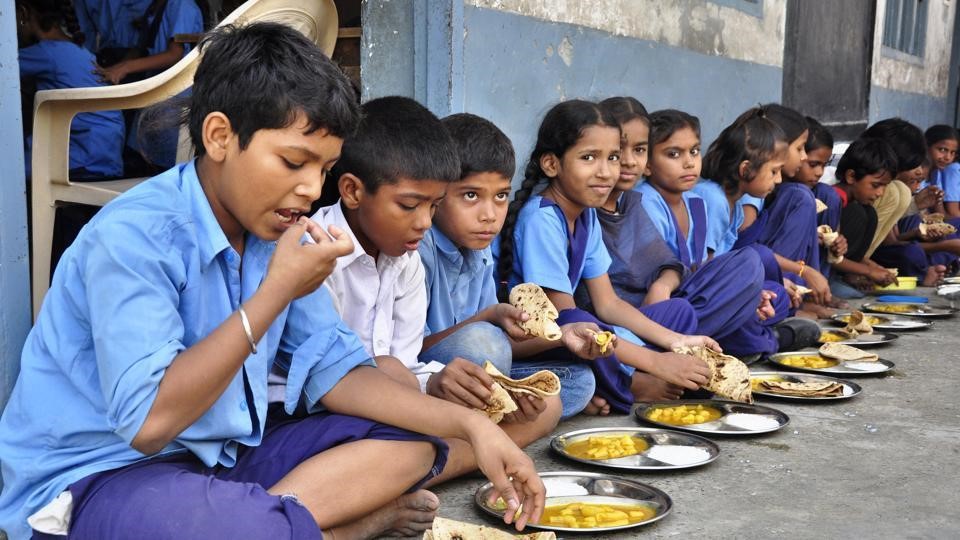
The government of India launched its flagship midday meal scheme program in 1995. It aims to eradicate malnutrition and raise the nutritional standards amongst school-age children. They provide them with free lunches in the government-aided school. It is one of its largest kind in the world that impacts around 120,000,000 children in over 1,265,000 schools and Education Guarantee Scheme centres.
The worsening conditions of malnourishment amongst school children make it pivotal for us to know the importance of invigorating such schemes in our country. India is home to around 195 million undernourished people and shares a quarter of the global hunger burden. Boosting nutrition and controlling stunted growth is one of the biggest challenges of this developing country. The National Family Health Survey (NFHS)-4 reports that India has an objectional high level of stunted growth amongst children. In 2015-16, 35.4% of children were underweight. According to the World Bank, a 1% loss in adult height due to childhood stunting leads to a 1.4% loss in economic productivity. The future of the Indian economy can be in jeopardy if we don’t fix these problems of stunted growth and increased malnourishment.
Midday meals are not monitored in an effective manner amongst various states. Uttar Pradesh recently encountered a case in September 2019 where students of a government school were eating only Roti and salt whereas they should be eating rice, roti, pulses and vegetables as a part of their detailed menu. There is a charge against the journalist who shot the video for defaming the government. But such videos are an eye-opener for the entire nation who is unaware of these mishappenings. The government then announced to conduct a quality audit of food served in its schools, only after the incident gained massive popularity. Another case of ShahJahanpur was in August 2019 where 26 students suffered from severe stomach pain after eating Khichdi and milk in their midday meal. The children who were of below 12 years of age got admitted to the Community Health Centre (CHC). It was again a case of food poisoning. Hence, strict monitoring of government schools took place in that area. Another incident of Warangal was on June 2019 when 12 children at an Anganwadi centre got hospitalised. There was a dead lizard found in the rice bowl. They immediately complained of nausea and showed symptoms of food poisoning. Although the children were out of danger, it reflects the lack of proper surveillance in these schools.
Even though such incidents prevail almost everywhere, very few have caught the
attention of media. The government orders supervisions and audits of food
quality control only when these incidents become of national importance.
Conducting stringent checks at regular intervals can reduce the frequency of
these incidents. An establishment of Accountability amongst the local level
government bodies is essential. They should observe and check the progress of
the implementation of the scheme. There should be a constant update even of the
difficulties faced by the cooks and the school officials. Lack of cooking sheds
and drinking water hinder the smooth process of serving meals. A rigorous check
of hygiene is also fundamental. Low maintenance of hygiene can make children
susceptible to illness.
A large proportion of children start school on an empty stomach. Without a midday meal, they lose interest in studying and go back home. The midday meals not only bolster the nourishment of children in these government schools but also help increase the student enrolment ratio. It is a huge incentive for the hapless parents to send their children to school so that they don’t sleep hungry. The children themselves look forward to eating with other children at noon. It makes them feel ease at school. Education too finds its way through these incentives. Thus, the entire nation can then witness the learning outcomes through such schemes. Social and private benefits that enhance the community is contingent on education. Midday meals mollify the short term hunger and revive concentration, health and nutritional status. All these lead to low absenteeism.
Midday meals are a quantum leap in the forward direction. They can foster a sense of social equality among school-children. It is the early years of primary school that are vital in children’s lives. It is when their understanding of social identity take shape. It also promotes gender equity and reduces the gender gap in school participation. States like Rajasthan and Chhattisgarh have witnessed a surfeit in female school participation. To sit and eat together at school, irrespective of caste is a strong way to defy the age-old prejudices. A survey by the Centre for Equity Studies revealed that open caste discrimination is not very common in context to midday meals. However, some discrimination towards the lower caste community occurred in states like Rajasthan with Dalit children. They were asked to eat and drink separately. There are times when even a Dalit cook is not allowed to cook. There are upper-caste parents also who are sceptical of the scheme, and few actively oppose it. They send separate lunch for their children and resist them sharing it with the lower castes. Since midday meals improve school-going, it can reduce future inequalities. Lack of education is a major source of economic disadvantage and social marginalisation.
Midday meals’ problems need permanent political priority and financial allocation. They are also a healthy blow to the existing inequalities of class, gender and caste. Having said this, India still has a long way to go in realising the full potential of midday meals. It should not miss out on this opportunity of becoming more economically and socially advanced.
Samridhi is public policy enthusiast who believes in one step at a time approach for sustainable development. She is a graduate in Economics honours from Daulat Ram College, Delhi University and currently a Post Graduate Diploma student of Economics at the Meghnad Desai Academy of Economics, Mumbai. She was Editor-in-Chief at The Economics Society, Daulat Ram College.